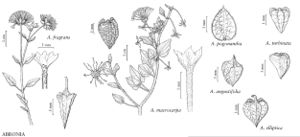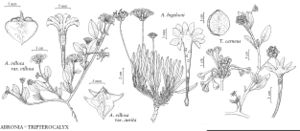Abronia
Gen. Pl., 448. 1789.
Herbs, annual or perennial, sometimes cespitose or appearing acaulescent, usually viscid-pubescent, from slender to stout taproot (extensively rhizomatous in Abronia bolackii). Stems prostrate to erect, unarmed, without glutinous bands on internodes. Leaves usually basal and cauline (all basal in A. bigelovii and A. nana), unequal in each pair, petiolate; blade ± thick and succulent, base usually asymmetric. Inflorescences axillary (appearing scapose in A. bigelovii and A. nana), pedunculate, capitate clusters, with peripheral flowers usually opening first; receptacle slightly rounded to conic, without pedicel-like projections; bracts persistent, not accrescent, 5–10, distinct, forming involucre, lanceolate to broadly ovate, thinly papery or scarious, translucent, occasionally thin and green. Flowers bisexual, chasmogamous; perianth radially symmetric, funnelform or salverform, constricted distal to ovary, abruptly expanded to 5-lobed limb; stamens 5–9, included; styles included; stigmas linear. Fruits winged or not, usually fusiform or turbinate, in profile rhombic, cordate, or obdeltate, coriaceous, glabrate to viscid puberulent; wings 2–5, opaque, subtly veined, not or only slightly extending beyond apex or base of body, distal margins sometimes dilated and flattened, broader than lamina, interior hollow, forming cavity, or filled with spongy tissue; sulci smooth or slightly rugose.
Distribution
North America, Mexico
Discussion
Species ca. 20 (19 in the flora).
Mature to near-mature fruits are usually required for identification of Abronia species because of the variation of vegetative structures within each taxon. Abronia appears to be in a state of active evolution. Cross-pollination readily occurs in the greenhouse, producing a variety of hybrids. Hybridization occasionally occurs in the field.
Selected References
Lower Taxa
Key
| 1 | Limb of perianth yellow or deep purplish red; plants perennial; stems prostrate, in vigorous plants forming large mats; seashores | > 2 |
| 1 | Limb of perianth white to magenta, never yellow or deep purplish red; plants annual or perennial; stems, when present, erect, ascending to prostrate, and then sometimes forming mats; mostly inland | > 3 |
| 2 | Limb of perianth yellow | Abronia latifolia |
| 2 | Limb of perianth deep purplish red | Abronia maritima |
| 3 | Plants perennial, acaulescent or nearly so, usually cespitose, rarely with short-branched aerial caudices; leaves all basal; inflorescences not prominently axillary, appearing scapose; wings on fruit not dilated | > 4 |
| 3 | Plants annual or perennial, usually caulescent, infrequently cespitose; stems elongate, rarely with short internodes; leaves basal and cauline (basal leaves sometimes absent on older plants); inflorescences prominently axillary; wings on fruit dilated or not | > 5 |
| 4 | Leaf blade 5 or more times as long as wide | Abronia bigelovii |
| 4 | Leaf blade less than 3 times as long as wide | Abronia nana |
| 5 | Fruits 2(-3)-winged; wings sometimes partially folded together, interior spongy filled | Abronia pogonantha |
| 5 | Fruits (2-)3-5-winged, or wings absent, if 2-winged, wings usually folded together, interior sometimes hollow, forming cavities | > 6 |
| 6 | Flowers 1-5 per inflorescence; peduncles shorter than subtending petioles | Abronia alpina |
| 6 | Flowers 6-80 per inflorescence; peduncles longer than subtending petioles | > 7 |
| 7 | Fruit wings (if present) thin, without cavities; fruits usually as wide as long | > 8 |
| 7 | Fruit wings (if present) compressed but appearing thick, cavity extending throughout interior of wings; fruits seldom as wide as long | > 10 |
| 8 | Fruit bodies coriaceous; wings (2-)3-5, if 2 then wings folded together to form single deep groove | Abronia mellifera |
| 8 | Fruit bodies indurate; wings 3-5 (rarely absent), not folded together | > 9 |
| 9 | Fruit bodies ± rugose-veined, seldom smooth; inland | Abronia villosa |
| 9 | Fruit bodies smooth, not rugose-veined; coastal | Abronia umbellata |
| 10 | Fruit wings dilated distally and flattened perpendicular to plane of lamina | > 11 |
| 10 | Wings of fruit not dilated distally, or wings absent | > 15 |
| 11 | Plants usually annual, occasionally perennial | > 12 |
| 11 | Plants perennial | > 13 |
| 12 | Perianth limb magenta to pale pink, infrequently pale rose; leaf blades mostly ovate to elliptic | Abronia angustifolia |
| 12 | Perianth limb white to pale pink; leaf blades broadly ovate to ± orbicu- late | Abronia turbinata |
| 13 | Perianth limb pale pink to light magenta; inflorescence bracts acute to attenutate at apex; fruits 4-7 mm; calcareous or gypseous soils | Abronia carletonii |
| 13 | Perianth limb white or greenish white; inflorescence bracts acute to obtuse or rounded at apex; fruits 5-12 mm; usually sandy or gravelly soils, sometimes gypseous | > 14 |
| 14 | Stems arising from a taproot; fruits 5-12 mm; flowers 25-75 per head; sandy soils, intermountain west | Abronia elliptica |
| 14 | Stems arising from long cordlike rhizomes; fruits 5-7 mm; flowers 15-25 per head; gypseous sandy or gravelly soils, nw New Mexico | Abronia bolackii |
| 15 | Wings of fruit absent | Abronia argillosa |
| 15 | Wings of fruit usually present (reduced to lobes in A. ammophila) | > 16 |
| 16 | Fruits stiffly coriaceous to indurate | > 17 |
| 16 | Fruits scarious | > 18 |
| 17 | Leaf blades 1-2.5 cm; fruits 4-6 mm, ± rhombic or fusiform in profile, tapered at both ends; peripheral fruits not or only slightly distorted | Abronia ammophila |
| 17 | Leaf blades usually 3-12 cm; fruits 5-12 mm, ± heart-shaped in profile (when wings not distorted), tapered at base, beaked within broad notch at apex; peripheral fruits often distorted and S-shaped in lateral view | Abronia fragrans |
| 18 | Fruit bodies smooth, reticulate veined at apex, ± 2 times as long as wide | Abronia ameliae |
| 18 | Fruit bodies sometimes rugose, not reticulate veined at apex; fruits 0.7-2 times as long as wide | Abronia macrocarpa |
"thick" is not a number."thin" is not a number.

